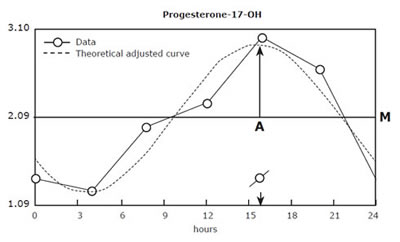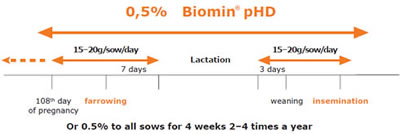
RRR and Biomin® pHD
From a thorough grooming of gilts, made of early introduction, quarantine, acclimatation, and feeding, to practical fertility matter, that is made of several factors : boar, insemination management, season, environment, nutrition, health.A boar must be chosen possibly from the same genetical house as gilts, if not and anyway, big competence or advisory is needed, but as general suggestion before purchasing new boars a period of trial with semen and check of siblings during life and at slaughter can give valuable data to make a decision. A good advice is always to remember that a boar can inseminate very many sows, a mistake would cost a lot. A boar is not a tractor, is not an exhibition animal. One simple evidence can help, genetically and animal is replicating himself so, again, a body judging is giving a first rough idea about what will come out.
Inside a farm the most important duties are heat detection and insemination, great care and skill have to be implemented. The item is to wide to be tighten in few lines, most recommendations given in farms are dealing mainly with timing of insemination; hygiene about semen collection, all instruments and during insemination; take care about the animals, gently keeping animals pays back, always and anyway; two boars to be used during stimulation, never only one, and they don't have to be kept in the same room as the sows, but come to the eros-center paying visit; the photoperiod is the base of physiological behavior, this embraces all from heat to parturition and even lactation.
All operators know the effect of hot season on sow fertility, against negative effects of warmth one can adopt cooling systems, otherwise feed consumption and fertility will be depressed. What is not always clear is the negative effect of decreasing photoperiod going towards autumn, a good practice entails to replace all neon gas lamps in sow rooms on 1st of August so as to counteract the natural die away of light hours and the decaying of lamps' efficiency that is measurable in "lux" units.

Figure 1: Daily photoperiods for various degrees north latitude
About environment to be taken into account a lot of parameters. There are worldwide governmental laws ruling about space allowance to sows, to contravene is detrimental to welfare and at the end of the day to technical results. Comfort in sow go from 16 to 24° C ( 60 to75°F), a lower temperature imply a higher feed consumption, a higher temperature change of physiological parameters, as quicker breathing and heart beating as signs, and with some negative effects on fertility. Also fluctuating of temperature must be taken care and avoided when wider than 5°C within 24 hours. Together with temperature comes ventilation, the higher the temperature goes the better must ventilation work, to bring oxygen and alleviate hot feeling; and also relative humidity that worsen the feeling of hot (or cold), there is a direct connection between humidity and temperature, as general clue one can take in mind that a relative humidity of 60 to 75 % is welfare range. But for sure the floor must be dry.
Re-bunching of animals have a great impact on fertility as well as many other parameters, in particular feed consumption in the first part of gestation that so much weight have on good establishing and continuation of gestation and recover of sow after lactation, energy intake is a main concern in all phases of production. About formulating of a diet is not difficult to make ready a sow feed, primal is to take care of raw materials and shelf life of stored vitamins.

A list of specific and non specific diseases causing fertility problems in the sow would be very long, a simple fever can change a lot. A good relationship with local veterinarian is really a strong point of success; blood sampling, to perform ELISA and/or PCR tests, at least twice a year to know and update the microbiological situation inside a sow herd, a good vaccination schedule are the milestones of professional business. During the last years some new challenges have been faced by operators, PRRS and then PCV2, these anyway have taught once for ever to all of us to take care "maniacally" about hygiene rules. But we don't have to forget historical sicknesses as Parvovirus, Influenza virus, Erysipelas, Streptococcus suis, E. coli, Leptospira, Brucella, and many others only locally or sporadically present. Let's go back finally to hygiene, as great ally of health, to underline the strategic importance of rodent control, made by professionals not played by ear by the farmer.
Urinary tract infections (UTIs) are often neglected pathologies, cause of easy subclinical course but, soon or later the bacteria responsible for UTI can be found in genital area (DA Dee), bringing decrease of fertility and pollution of uterus and udder, leading to MMA syndrome and sow culling. When a farmer can see discharge from the vulva in one animal it is already late for a valuable intervention. Unless drugs that anyway kill indiscriminately bacterial population in the urinary tract and leaving an unprotected milieu to a new unknown bacterial growth, there are very few or none other weapons to treat this affections. Prevention is by far the better way, drugs as said are not of great help, acidification is on the other hand a not yet widely adopted procedure. Biomin® pHD in this aspect is a very effective mean to prevent UTIs, by acidification of urine and protection of mucosal wall. It is administered one week before farrowing till one day after insemination, in alternative twice a year fed to the whole sow herd, it is a great enhancer of fertility and a Calcium mobilizer to create the best preliminary condition for muscle contraction and hence a valid farrowing so as to decrease stillbirth and a main reason of infection, caused by feeble farrowing and introduction of hands to help piglets to come out.


Figure 2: Circadian rhythm of Thyroxine and progesterone in sow (Toniollo G.H et al.)
To end we think it nice to recall that in the Netherlands they have the rule of the three "R" that is perfect for sow keeping: rust, reinheid, regelmaat, that mean quiet, cleanness and regularity. While the first two are easy to understand, regularity needs an explanation. A regular provision of any service and feeding to animals goes with regular hormonal cycling, starting from those that have a daily one and, at the end of the day, monthly reproduction hormones.
Fertility in sow is a the result of a complex of factors, environment, nutrition, genetic and diseases don't have to be the alibi for bad management, that is what can be improved without expenses or outer intervention.
Biomin® pHD advantages
Administered starting from some days before farrowing elevates the blood calcium, preventing feeble parturition and making easier newborning expulsion, avoiding this way a good percentage of stillbirth piglets. Attention must be put upon usage of oxitocin, mainly when the administration is frequent or systematic, assuring Biomin® pHD a valid level of calcium in the blood less amount of oxitocin is often needed, or is better the injection of the releasing factor from posthipophisis gland that is more physiological and long lasting. Some days before mating avoids to inject pathogen bacteria with insemination catheter, preventing this way a chance of infection deeply in the genital tract.
Urinary acidifications provide anytime during the year a valid barrier against cystitis and further ascending affections of urinary tract, which often lead to genital diseases and hence reproductive failure. After or during antibiotic administration via feed in large groups of sows Biomin® pHD prevents growing of pathogen, often basophilic, bacteria.

For Further Product Information Please Visit www.biomin.net
Featured Products

Biomin® pHD
Decrease to Increase
Related Articles

Biomin® pHD
Effect of urinary acidifier on reproduction performance in sows

Biomin® pHD
Use of anions and cations in sows

Biomin® pHD
RRR and Biomin® pHD
Related Services

Mycotoxin Channel
World renowned experts answer mycotxin related questions.

Mycotoxins.info
A wealth of Mycotoxin information at your fingertips

World Nutrition Forum
The future of animal nutrition






